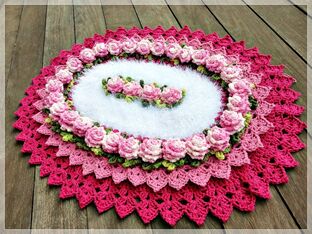Crochet needles are essential tools for anyone who wants to venture into this world of yarns and textures.
Choosing the right needle directly influences the result of your work, from ease of handling to the final finish of the piece.
In this article, we'll explore the different types of crochet hooks, from sizes and materials to their specific uses.
You will learn how to choose the ideal needle for each project and will also receive valuable tips for taking care of your needles, ensuring their durability and the success of your crochet work.
We'll explore the different types of needles, how to choose the best one for each project, and how to care for them to make them last a long time.
Crochet Hook for Beginners
For those who are just starting out in crochet, choosing the right hook can make all the difference.
Generally, it is recommended to start with aluminum or plastic needles, with a thickness between 3.5mm and 5mm.
These materials are lightweight, easy to handle and glide smoothly over the wires, making learning more enjoyable.
Thicker needles make it easier to see the stitches, which is essential for beginners.
Remember: Start with simple projects, like squares or scarves, to practice the basic stitches and get familiar with the needle.
Crochet Hooks and Yarn Chart
A crochet hook and yarn chart can be a very useful tool, especially for beginners.
This table shows the correspondence between yarn thickness and recommended needle size.
There are charts available online and in crochet books, and they can help you avoid mistakes when choosing a hook, ensuring that your project turns out as you want it to.
Tip: Print a table and keep it handy to make your choices easier.

Crochet Hooks Sizes
Crochet needles They come in a variety of sizes, each ideal for specific yarns and projects. Choosing the right size is crucial to the success of your work.
Smaller sizes create tighter stitches, ideal for delicate pieces like amigurumis and lace doilies.
Larger ones produce looser stitches, perfect for blankets, scarves and pieces with thicker textures.
Crochet hook numbering generally follows an international standard, although there are some variations.
Sizes are indicated by letters (for smaller sizes) and numbers (for larger ones).
For example, needles from 0.6mm to 1.75mm are often represented by letters B through I, while sizes from 2mm to 10mm (and beyond) are represented numerically.
It is important to check the correspondence between letters and millimeters, as there may be small differences between manufacturers.
The thickness of the yarn also directly influences the choice of needle. Thinner yarns require smaller needles, while thicker yarns require larger needles.
Using an inappropriate needle can result in work that is too tight (making crocheting difficult) or too loose (compromising the structure of the piece).
To make things easier, most yarn manufacturers indicate the recommended needle size on the label.
Experimenting with different needle and yarn combinations can help you find what works best for your style and project.
How to Measure a Crochet Hook
To measure your needle and ensure you are using the correct size, you can use a needle gauge, which is usually shaped like a ruler or disc with holes of different diameters.
Simply insert the needle into the corresponding hole to identify its size.
If you don't have a gauge, you can use a caliper to measure the diameter of the needle head.
Crochet Hooks and Yarn Chart
| Needle Size (mm) | Wire Thickness | Project Types |
|---|---|---|
| 2.00 – 2.50mm | Fine yarns, crochet threads, fine mercerized cotton | Small amigurumis, delicate details, lace pieces, jewelry |
| 2.75 – 3.50mm | Mercerized cotton yarns, silk yarns, fine acrylic | Amigurumis, baby clothes, washcloths, light scarves |
| 4.00 – 5.00mm | Acrylic yarn, medium wool, fine twine | Clothing items, blankets, sweaters, scarves, hats |
| 5.50 – 6.50mm | Thick threads, thick wool, twine | Thick blankets, rugs, bulky scarves, decorative pieces |
| 7.00mm – 10.00mm+ | Very thick yarns, thick strings, super bulky wool | Thick rugs, bulky decor pieces, crochet baskets |
Remember: This table is a general guide. Choosing the right hook may vary depending on the yarn you choose and the tension you use to crochet.
Testing different needle and yarn combinations is essential to get the best results.
The same yarn can be worked with different needle sizes to create different textures and effects in your project.
Experiment and find what works best for you!
Tip: The yarn packaging usually recommends the ideal needle size for that particular yarn. Pay close attention to this information.
Finding the Perfect Crochet Hook
From crochet hooks for beginners to understanding the crochet hook and yarn chart, we explore the main types and sizes to help you master the art.
Remember that choosing the right needle, matching the right yarn, is crucial for the success of your project.
Experiment with different types and sizes of needles to find which one best suits your style and the project you want to create.
With practice and the right tools, you will be creating amazing crochet pieces!
Now that you know the 5 types of crochet needles, how about starting to practice?
FAQ – Frequently Asked Questions About Crochet Hooks
What is the best crochet hook for beginners?
For beginners, we recommend aluminum needles with rubberized handles and sizes between 3.5mm and 5mm. They are easy to handle and comfortable for learning the basic stitches.
How to choose the size of the crochet hook?
The ideal needle size depends on the type of yarn and the project you want to make.
The crochet hook and yarn chart is a great tool to help you make this choice. Generally, the hook thickness is indicated on the yarn packaging.
Where can I find a crochet hook and yarn chart?
You can find crochet hook and yarn charts on craft websites, haberdashery stores, and even on yarn packaging.
These tables show the correspondence between yarn thickness and recommended needle size.
What are the different types of crochet hooks?
There are several types of crochet hooks, such as aluminum, bamboo, steel and plastic. Each material has its own characteristics and advantages.
Aluminum ones are the most common, bamboo ones are light and comfortable, steel ones are ideal for delicate work and plastic ones are good for thicker threads.
How do you know if a crochet hook is of good quality?
A good quality needle should have a smooth finish, without burrs, so that the thread slides easily.
The handle should also be comfortable to hold and not cause discomfort during prolonged use.
Where can I buy crochet hooks?
Crochet hooks can be found in craft stores, haberdashery stores, online stores and marketplaces.






